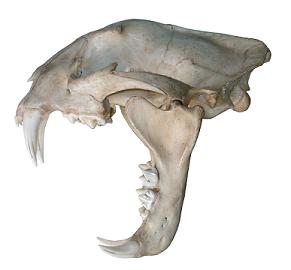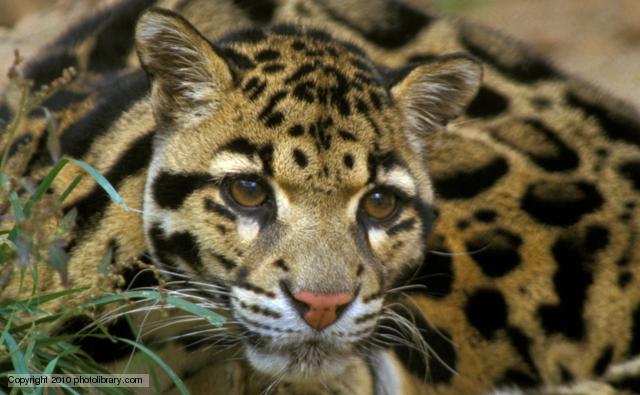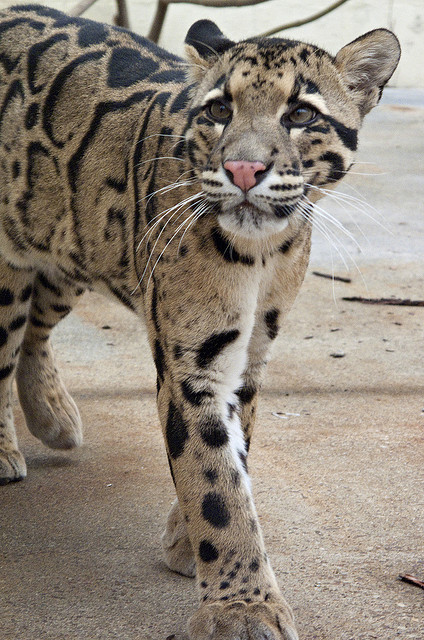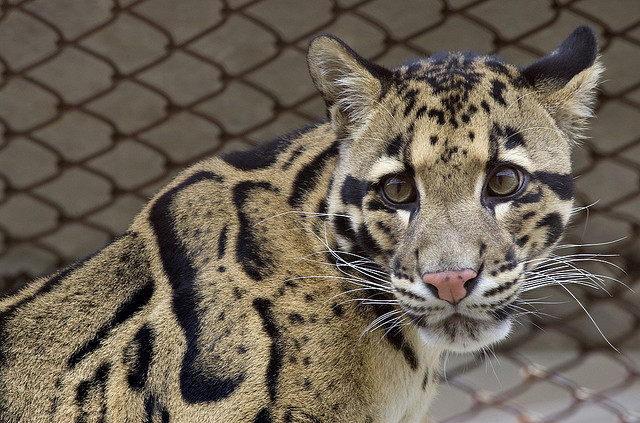Arboreality in Clouded Leopards (Neofelis nebulosa)
Biology 342 Fall 2015
Avehi Singh & Karla Velarde
Copyright BBC Nature Wildlife website, 2010.
BASICS
The clouded leopard (Neofelis nebulosa) is defined as a large spotted cat, found in Southeast Asia, that hunts in trees at twilight (Google Definition). Clouded leopards are medium-sized cats that usually stand 10-16 inches tall and are 4-6 feet long, the tail taking up almost half of its length. Males tend to be larger in this species, weighing up to 50 pounds, while females are smaller and total up to an average of 35 pounds. Clouded leopards have been recorded to live up to 17 years in captivity, but little is known about their wildlife survival due to their elusive nature. They are the best climbers in the cat family, and they have even been spotted hanging upside down on trees.

Clouded leopard range, copyright National Geographic, 1996-2015.
Clouded leopards inhabit the foothills of the Himalayan mountains through Southeast Asia. They are currently classified as a vulnerable species by the International Union for Conservation of Nature (IUCN). The clouded leopard was recently sub-divided into two species of wild cat: the Neofelis nebulosa, restricted to mainland Southeast Asia, and the Sunda clouded leopard (Neofelis diardi) found on the islands of the Sumatra and Borneo (Wilting. Feldhaar et al. 2007). They are the smallest of the big cats and are considered an evolutionary link between the small cats and the big cats; having close anatomical resemblance to the saber-toothed cat.
The clouded leopard is a very rare and secretive animal that prefers to remain alone and hidden from view. They lead largely arboreal lives, and are skilled climbers capable of acrobatic feats of strength and balance. These majestic cats are solitary, mostly nocturnal hunters (Lynam et al. 2013), making them difficult to spot and study in their natural habitat.
DISTINCTIVE CHARACTERISTICS OF THE CLOUDED LEOPARD
Copyright Smithsonian National Zoological Park flickr album, 2015.
The clouded leopard was named after its distinctive coat pattern. They sport cloud-like patterns on their coats formed by a combination of white, beige, gold, grey, and black fur. They have long canine teeth and an unusual skull structure. They are often compared to the saber-toothed cat as they have the longest upper canine teeth in relation to skull size in the extant cat family (Clouded Leopard Project 2003-2011). Their short legs, greatly enlarged forefeet, and extremely long tail enhance their arboreal locomotion. To summarize, clouded leopards differ from the rest of the cat family because of their high reliance on arboreal locomotion, which has allowed them to increase their survival rate and their lifetime reproductive success.

Copyright David Lawson / WWF-UK 2015. The picture shows the length of the clouded leopard's tail.

Clouded leopard skull showing gape and canines. Copyright the Clouded Leopard Project website, 2003-2011.
WHAT MAKES THE CLOUDED LEOPARD DIFFERENT FROM OTHER BIG CATS? ARBOREAL LOCOMOTION!
The clouded leopard is the only big cat of the subfamily Pantherinae that is almost exclusively arboreal. The habitats it inhabits pose mechanical challenges for locomotion such as moving on narrow branches, moving up and down inclines, balancing, crossing gaps, and dealing with obstructions. In response, clouded leopards have evolved a variety of anatomical and behavioral adaptations to allow them to tackle these challenges. These include limb length, prehensile tails, claws, adhesion, gripping, reversible feet, low center of mass and small size. Through these adaptations they can climb down vertical tree trunks headfirst and hang onto branches by bending their hindlimbs around the branches. They hang off branches using their hindlimbs and tail and can climb onto horizontal branches with their back to the ground and can even make short jumps in this position. Their tails help them balance on thin branches. They can easily jump up to 1.2 m (3.9 ft) high (Clouded Leopard Project 2003-2011). The clouded leopard is a great animal to study because it has adapted to its environment by maximizing its survival rate and overall lifetime lifetime reproductive success through the use of arboreal locomotion.
DEFINITION OF ARBOREAL LOCOMOTION
Arboreal locomotion is the locomotion (movement) of animals in trees. In habitats with trees, animals have evolved to move in them as a way to elongate senescence and increased longevity (Shattuck & Williams 2010). These habitats pose many unique mechanical challenges for animals moving through them, leading to a variety of anatomical, behavioral, and ecological adaptations which vary between species. This leads to anatomical specializations such as change in limb length, prehensile tails, claws, adhesion, gripping, reversible feet, low center of mass, small size, among others. The clouded leopard has adapted some of these anatomical specializations over time because they have allowed the organism to survive.
To listen to a clouded leopard roar click on the following link.
Class: Mammalia
Order: Carnivora
Family: Felidae
Species: Neofelis nebulosa


